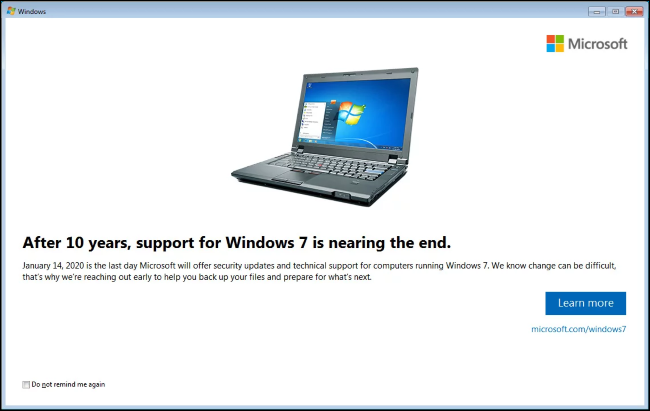January 2020 sees the official retirement of Windows 7.
 All good things must come to an end, and January 14th 2020 sees the Windows 7 operating system finally go into official retirement. Just like the end of Windows XP in 2014, Microsoft will no longer be supporting this platform nor offering any ongoing security updates patches or fixes for PC’s still running Windows 7.
All good things must come to an end, and January 14th 2020 sees the Windows 7 operating system finally go into official retirement. Just like the end of Windows XP in 2014, Microsoft will no longer be supporting this platform nor offering any ongoing security updates patches or fixes for PC’s still running Windows 7.
What does it mean?
The single biggest risk to running Windows 7 past the End of Life date is the vulnerability factor. Without the regular security updates patches and fixes that Microsoft provide it is likely that cyber criminals will target Windows 7 users just like they did with Windows XP back in 2014.
Windows 7 will continue to run after the deadline and some users may choose to run the risk, but be that at their peril, there will be no redress from Microsoft and should a security breach occur, you could be looking at some pretty steep costs from an IT support vendor, as well as financial and reputational damage.
That said, any IT support company that does not warn its customers of these risks or is prepared to support Windows 7 post January 2020 is probably naïve, ignorant or cares little for their own or their customers reputations.
What are my options?
Well the obvious choice would be to upgrade to Windows 10, but there are other things think about here.
Here’s Microsoft’s published minimum PC spec for Windows 10:
- Processor: 1 gigahertz (GHz) or faster processor or SoC.
- RAM: 1 gigabyte (GB) for 32-bit or 2 GB for 64-bit.
- Hard disk space: 16 GB for 32-bit OS 20 GB for 64-bit OS.
- Graphics card: DirectX 9 or later with WDDM 1.0 driver.
- Display: 800 x 600 resolution
Whilst the official Microsoft minimum specification is woefully low, it will still run. The reality is it won’t run well and could even make your PC’s perform slower than with Windows 7!
In our experience and opinion, we’d recommend at least a 2GHz dual-core processor, 4GB of RAM (8GB ideally) and an SSD drive with a minimum capacity of 256GB for Windows 10 to run well and at an acceptable level for end-users.
When you consider that your employees time is not free, then it would seem sensible to provide them with the tools to get the job done as quickly possible, for this will surely impact your bottom line on way or another.

You have to replace all of your PC’s, right?
It is likely that many IT service providers will be banging the “Replace all Windows 7 PC’s” drum, but that may not always be the most appropriate or cost-effective solution for all.
In terms of making the decision to replace or upgrade your hardware to accommodate Windows 10 here are a few things to consider:
The cost of upgrade versus replacement
If hardware is really old (as a guide older than 5-6 years) then it may well be worth considering replacing those PC’s as it will likely make the most financial sense to do so.
When we consider the cost of a Windows 10 upgrade, which can be anywhere between £90 up to £160 per PC (for legitimate software, the installation costs and potential downtime), replacement can often be the most sensible choice.
That said, if a PC is borderline and has a reasonable processor then upgrade could well be the best option. Upgrading to 8Gb of memory and a 500Gb SSD drive could cost less than you think, coming in well under £100.
Additionally, using the right techniques to automatically pre-build the hard drives before fitting in the PC’s could also save substantial installation costs and user downtime, making this a very viable and attractive option.
With the advent of Cloud computing, hosted platforms and an array of internet-based applications such as Office 365, it could be an opportunity to evaluate this option as the power of PC’s in this scenario is much less important. The considerations for looking at a Cloud solution is a discussion in it’s own right and we will be covering that in a future blog. Suffice to say that you should at least have this conversation with your IT vendor or shop around to get informed feedback to assess if this option could be beneficial for you.
Is there a way to upgrade to Windows 10 for free?
Well interestingly, the answer to that is potentially yes. Even though the official date for the end of the free upgrade to Windows 10 was back in July 2016, it seems that under the right circumstances and using the right techniques, Microsoft are still processing these free upgrades.
As long as you have a legitimate Windows 7, 8 or 8.1 product key there is a good chance this could work for you.
I would not recommend you go ahead and attempt this yourself but if you speak to your IT service providers, they should be aware of this process and how appropriate and successful it is likely to be in your case.
Could this be an opportunity?
 In our experience, it is usually only when something goes wrong or there is a forced decision to be made like this one, that SMB’s actually take some time to review their current IT systems and options.
In our experience, it is usually only when something goes wrong or there is a forced decision to be made like this one, that SMB’s actually take some time to review their current IT systems and options.
Because this End of Life situation draws a line in the sand and only the most foolhardy will do nothing, it presents a great opportunity to review your technology platform and take advantage of the many ways it can add substantial value to your business and your workforce.
It never ceases to amaze me when we evaluate a prospects system after they approach us for advice about a Windows 7 upgrade, as we almost always find many other areas of risk and opportunity.
Business owners are often surprised at the reality of the state of their IT systems that they were previously oblivious too, so the Windows 7 situation can indeed act as a great catalyst for positive change in so many other ways.
If your current IT provider does not seem open or flexible to all options, then it may be worth shopping around, if nothing else you will get a benchmark against what you have in place. By getting alternative opinions and ideas you can at least challenge your provider to ensure you get the very best solution to manage your Windows 7 replacement as well as other positive benefits as a by-product.
This is even more likely if you are also using other Microsoft operating systems or applications that are also coming to end of life in 2020, click here to see the full list on the official Microsoft pages.
https://support.microsoft.com/en-gb/help/4470235/products-reaching-end-of-support-for-2020





